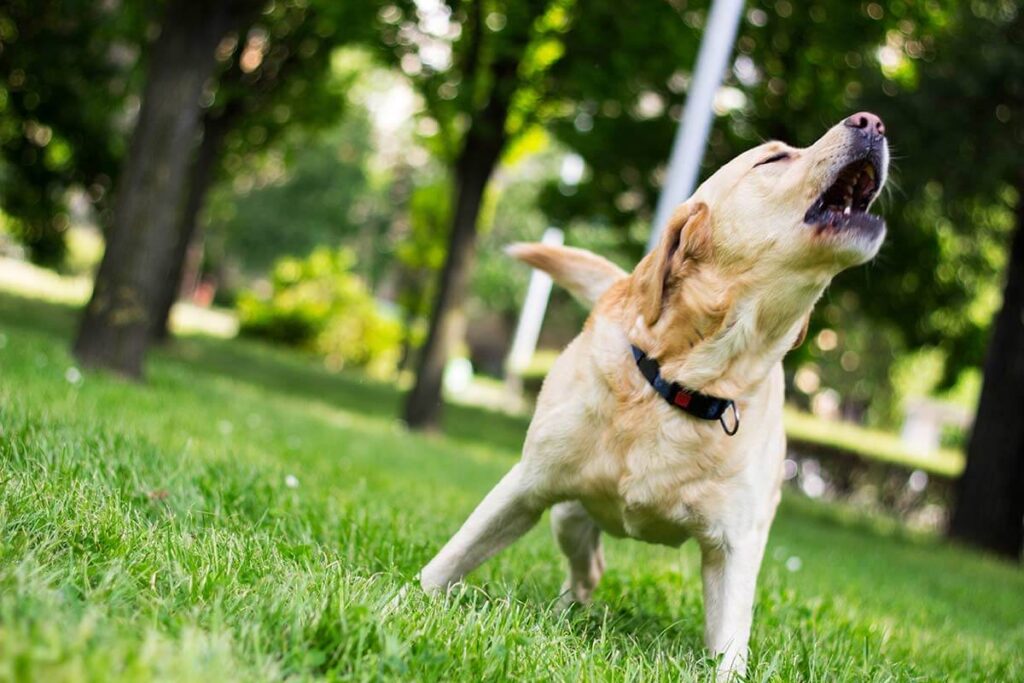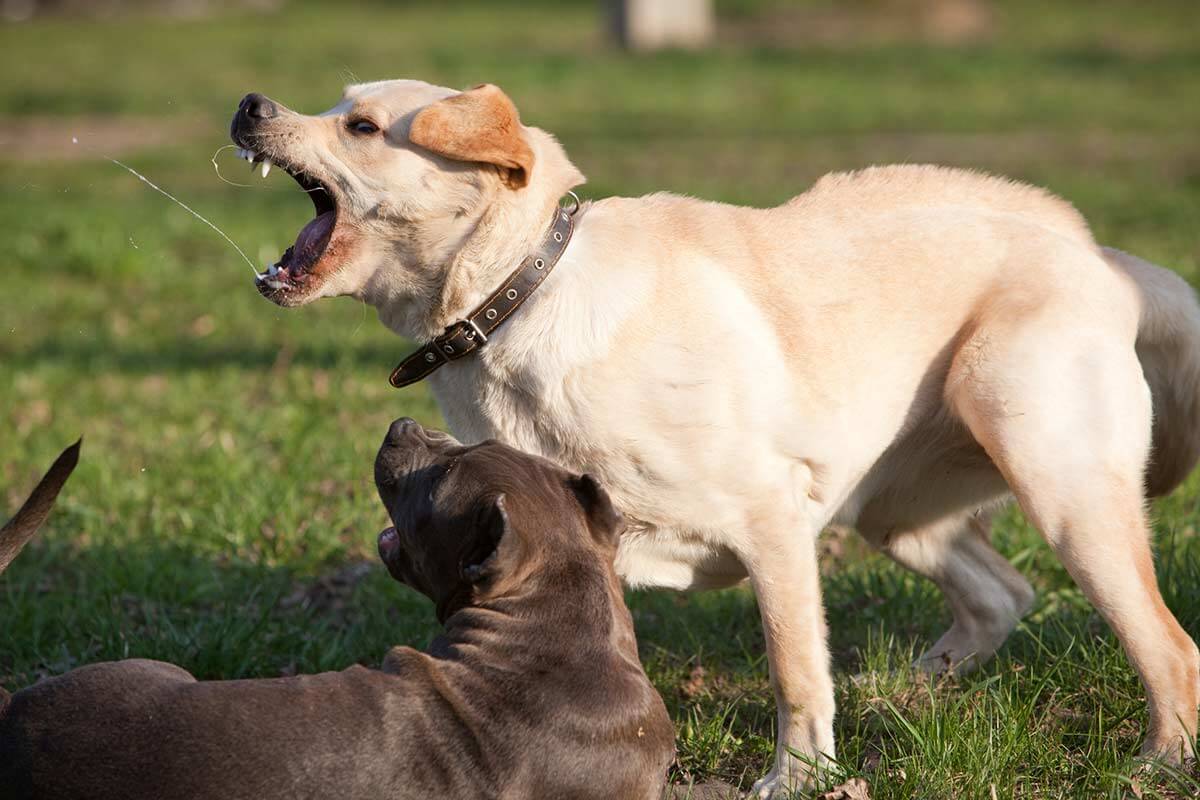Labradors are known for their outgoing, friendly, and energetic personalities. Unfortunately, this can sometimes lead to aggression if they don’t get the proper training and guidance. This can be especially problematic if your Labrador is an adult dog and has already developed aggressive behaviors.
You can deal with an aggressive Labrador by using positive reinforcement techniques. Reward positive behavior such as sitting, coming when called, and good leash walking with treats or verbal praise. Punishing aggressive behavior is not recommended, as this can worsen the behavior.
In this article, I’ll discuss the reasons behind aggression in Labradors, what you can do to address it, and ways to deal with aggressive behavior effectively. So if you’re dealing with an aggressive Labrador, keep reading for some helpful tips.
Table of Contents
1. Identify the Cause of Aggression
Before addressing the issue of aggression in Labradors, it’s essential to understand why your pet is exhibiting aggressive behavior. If you can identify the root cause, you can use this knowledge to develop an appropriate behavior plan for your pet.
Here are some reasons behind aggression in Labradors:
- Anxiety: Anxiety can cause Labradors to become fearful and defensive. This can lead to aggressive behavior to protect themselves or their territory.
- Territorial aggression: Labradors naturally protect their homes, family, and possessions. They may show signs like growling, barking, and displaying their teeth when they feel their territory is threatened.
- Unsuitable environment: If your Labrador is not in a suitable environment, they may display aggressive behavior. This could be due to boredom, lack of exercise or mental stimulation, too much attention, or insufficient space.
- Fear-based aggression: Labradors may become aggressive if they’re scared or feel threatened. Signs that indicate fear include pulled-back ears, a tucked tail, and rigid body language.

2. Develop an Effective Training Plan for Your Labrador
Once you have identified the cause of aggression in your Labrador, developing an effective training plan is essential. Training should be based on positive reinforcement.
The goals of the training plan should include the following:
- Establishing yourself as the alpha of your pack.
- Instilling obedience and good manners in your pet.
- Teaching your Labrador to respond to basic commands.
- Reducing stress and anxiety in your pet.
- Creating a safe environment for interactions between humans and pets.
Here’s a brief example of a Labradors behavior training plan:
Start With the Basics
- Begin each training session with 10 minutes of exercise and play to help your Labrador relax.
- Train your Labrador to respond to basic commands like “sit” and “come”.
- Reward positive behaviors with treats and verbal praise.
- Practice basic obedience commands with your Labrador.
Introduce Distractions
- Once your Labrador responds to basic commands, introduce distractions like another person, a toy, or a treat. This will help your Labrador learn to stay focused and respond appropriately in the presence of distractions.
- Continue to work on obedience commands with distractions present.
Socialization
- Introduce your Labrador to different people and animals in a controlled environment.
- Reward good behavior during these interactions with treats and verbal praise.
- Continue to reinforce good behavior during subsequent interactions.
3. Establish Yourself As the Alpha of Your Pack
Establishing dominance is vital to set boundaries and expectations for your pet’s behavior. Not only will this help reinforce good behavior, but it will also allow you to control your pet’s aggression better.
Establishing yourself as the alpha of your pack can be done in several ways:
- Be consistent with your training and commands.
- Practice obedience and good manners regularly.
- Maintain a calm and assertive demeanor when dealing with your pet. This means not reacting to aggression with aggression.
- Take charge of feeding, grooming, and exercise times.
- Ensure your Labrador understands that you’re in charge by maintaining eye contact and using a firm, low-pitched voice.
- Set boundaries and give clear expectations for behavior. Make sure your pet knows what is and isn’t acceptable.
- Be patient and reward good behavior with treats, verbal praise, and physical affection.
- Don’t let your dog be the first one out the door.
- Don’t let your dog jump up on you or your guests.
- Never let your Labrador pull on the leash when walking. This will help to establish that you’re in control.
4. Use Positive Reinforcement When Training Your Dog
Positive reinforcement is one of the most effective ways to train your Labrador. Positive reinforcement rewards good behaviors with the following:
- Treats
- Verbal praise
- Physical affection
This type of reinforcement will encourage your dog to repeat the behaviors they’re rewarded for. It’s essential to be consistent with the rewards. If you give one treat for good behavior, always provide the same number of treats.
When training your Labrador, focus on teaching basic commands such as:
- Sit
- Stay
- Come
- Lie down
These commands should be short and easy to understand. Always reward good behavior. Never punish your pet for bad behavior. Instead, redirect their attention to something more positive.
Practice these commands in different settings and locations to ensure your Labrador knows them well. This will help to reinforce the commands and build a strong bond between you and your pet.
Best Treats To Reward Positive Behavior
Treats are an essential part of positive reinforcement training. Choosing a treat your Labrador loves will encourage them to repeat behaviors they’re rewarded for.
Here are three of my top picks for best treats to reward positive dog behavior (available on Amazon.com):
Milk-Bone Original Dog Treats Biscuits
Good’N’Fun Triple Flavored Rawhide Kabobs
Pup-Peroni Dog Treats with Real Beef Brisket, Hickory Smoke Flavor
5. Give Your Dog Regular Exercise and Mental Stimulation
Labradors are highly energetic and need regular exercise to stay healthy and happy. A lack of exercise can lead to boredom, increasing the risk of aggressive behavior.
Make sure to provide your Labrador with daily exercises, such as 80 minutes of walking or playing games in the park. Interactive dog toys can also provide mental stimulation and help prevent your Labrador from becoming bored.
In addition, participating in obedience or agility classes can help further to improve your Labrador’s socialization skills and obedience. These activities also allow you and your dog to bond and have fun together. Best of all, these activities can help reduce aggression and improve their overall mood and behavior.
Best Interactive Dog Toys for Labradors
Interactive dog toys are a great way to mentally and physically stimulate your Labrador. You can reduce the risk of aggression by providing them with various toys and keeping your pup entertained and focused on something positive.
Here are three of my favorite choices from Amazon.com to help you get started:
Tuwicx Durable Motion Activated Automatic Rolling Ball
ChuckIt! Ultra Ball
Feeko Dog Rope Toys
In addition to being an excellent way to expend your pup’s energy and reduce frustration, tug-of-war games also help strengthen the bond between you and your Labrador.
Best Mental Stimulation Toys for Labradors
If you need to leave your Labrador alone while at work or running errands, ensure they have enough stimulating toys to keep them occupied. Providing interactive toys that require problem-solving skills can help distract them from destructive behaviors and keep them from getting aggressive.
Here are three of my favorite choices from Amazon.com to help you get started:
PETSA Dog Puzzle Toys
SodaPup Red Bones & Blue Jigsaw eMat
QINGFANGLI Spring Pole Dog Rope Toys
6. Establish Boundaries and Rules
In addition to providing interactive toys and engaging activities, establishing boundaries and rules is also essential in curbing aggressive behavior in Labradors.
Establish a routine that is not only consistent but also one that your dog can understand. Let them know what behaviors are and are not acceptable with verbal cues or hand signals. Boundaries and rules can be constructive when teaching your pup not to jump on people or furniture.
Here are a few practical tips you can follow to ensure your Labrador understands the rules:
- Give your dog attention only when you invite them.
- Offer a time-out or remove them if your dog gets too excited and breaks the rules.
- Establish a no-barking or no-jumping rule.
- Include obedience training as part of your routine, such as teaching your dog to sit or stay.
- Ask visitors to respect the boundaries and regulations you have established for your Lab.
Wrapping Up
Labradors are known for their friendly, outgoing personalities and can be wonderful companions. However, it is essential to remember that they require guidance, exercise, and mental stimulation to ensure they remain well-mannered and free of aggression.
By giving them interactive toys, playing games with them, and teaching them boundaries and rules, you can help create a safe environment for your Labrador. With enough patience, love, and attention, you can ensure that your best friend remains an obedient and well-behaved companion for years to come.




